Investigation of Microstructural Features and Mechanical Characteristics of the Pressureless Sintered B4C/C(Graphite) Composites and the B4C-SiC-Si Composites Fabricated by the Silicon Infiltration Process
Abstract
:1. Introduction
2. Experimental Procedures
2.1. Materials and Fabrication
2.1.1. Fabrication of the B4C/C(Graphite) Composites by Pressureless Sintering
2.1.2. Fabrication of the B4C Monolith by Pressureless Sintering
2.1.3. Fabrication Process of the B4C-SiC-Si Composites by Silicon Infiltration Process
2.2. Characterizations
2.2.1. The Microstructure and Phase Composition of Pressureless Sintered Specimens and Silicon Infiltrated Specimens
2.2.2. The Mechanical Property and Wear Resistance of Pressureless Sintered Specimens and Silicon Infiltrated Specimens
3. Results and Discussion
3.1. The Phase Composition of the B4C/C(Graphite) Composites Fabricated by the Pressureless Sintering Process
3.1.1. The Phase Composition of the B4C Monolith Fabricated Using a Pressureless Sintering Process
3.1.2. The Phase Composition of the B4C/C(Graphite) Composites Produced by Pressureless Sintering
3.2. The Microstructural Features of the B4C/C(Graphite) Composites Fabricated by the Pressureless Sintering Process
3.2.1. The Microstructural Features of the B4C Monolith Fabricated by the Pressureless Sintering Process
3.2.2. The Microstructural Features of the B4C/C(Graphite) Composites Fabricated by the Pressureless Sintering Process
3.3. The Phase Composition of the B4C-SiC-Si Composites Fabricated by the Silicon Infiltration Process
3.3.1. The Phase Composition of the B4C-SiC-Si Composites Fabricated by Silicon Infiltration of Pressureless Sintered B4C Monolith
3.3.2. The Phase Composition of the B4C-SiC-Si Composites Fabricated by Silicon Infiltration of Pressureless Sintered B4C/C(Graphite) Composites
3.4. The Microstructural Features of the B4C-SiC-Si Composites Fabricated by the Silicon Infiltration Process
3.4.1. The Microstructural Features of the B4C-SiC-Si Composites Fabricated by Silicon Infiltration of Pressureless Sintered B4C Monolith
3.4.2. The Microstructural Features of the B4C-SiC-Si Composites Fabricated by Silicon Infiltration of Pressureless Sintered B4C/C(Graphite) Composites
3.5. The EDS Spectrum of the B4C-SiC-Si Composites Fabricated by the Silicon Infiltration Process
3.6. The Mechanical Property of the Pressureless Sintered B4C/C(Graphite) Composites and the B4C-SiC-Si Composites
3.6.1. The Density and Relative Density of the Pressureless Sintered B4C/C(Graphite) Composites and the B4C-SiC-Si Composites
3.6.2. The Fracture Strength and Fracture Toughness of the Pressureless Sintered B4C/C(Graphite) Composites and the B4C-SiC-Si Composites
3.6.3. The Vickers Hardness and Elastic Modulus of the Pressureless Sintered B4C/C(Graphite) Composites and the B4C-SiC-Si Composites
3.7. The Wear Resistance of the Pressureless Sintered B4C/C(Graphite) Composites and the B4C-SiC-Si Composites
3.8. Formation Mechanism of the B4C-SiC-Si Composites via Silicon Infiltration Process
4. Conclusions
Funding
Institutional Review Board Statement
Informed Consent Statement
Data Availability Statement
Conflicts of Interest
References
- Chen, M.W.; McCauly, J.W.; LaSalvia, J.C. Microstructural characterization of commercial hot-pressed boron carbide ceramics. J. Am. Ceram. Soc. 2005, 88, 1935–1942. [Google Scholar] [CrossRef]
- Cho, N.; Bao, Z.H.; Speyer, R.F. Density-and hardness-optimized pressureless sintered and post-hot isostatic pressed B4C. J. Mater. Res. 2005, 20, 2110–2116. [Google Scholar] [CrossRef]
- Tamburini, U.A.; Munir, Z.A.; Kodera, Y. Influence of synthesis temperature on the defect structure of boron carbide: Experimental and modeling studies. J. Am. Ceram. Soc. 2005, 88, 1382–1387. [Google Scholar] [CrossRef] [Green Version]
- Jung, J.W.; Kang, S.H. Advances in manufacturing boron carbide-aluminum composites. J. Am. Ceram. Soc. 2004, 87, 47–54. [Google Scholar] [CrossRef]
- Heian, E.M.; Khalsa, S.K.; Lee, J.W. Synthesis of dense, high-defect-concentration B4C through mechanical activation and field-assisted combustion. J. Am. Ceram. Soc. 2004, 87, 779–783. [Google Scholar] [CrossRef]
- Lee, H.; Speyer, R.F. Hardness and fracture toughness of pressureless-sintered boron carbide (B4C). J. Am. Ceram. Soc. 2002, 85, 1291–1293. [Google Scholar] [CrossRef]
- Yamada, S.; Sakaguch, S. Mechanical properties of boron carbide ceramics. Ceram. Eng. Sci. Proc. 2001, 22, 215–220. [Google Scholar] [CrossRef]
- Solodkyi, I.V.; Bogomol, I.I.; Vterkovskyi, M.Y.; Loboda, P.I. Low-temperature synthesis of boron carbide ceramics. J. Superhard. Mater. 2018, 40, 236–242. [Google Scholar] [CrossRef]
- Hayun, S.; Kalabukhov, S.; Ezersky, V.; Dariel, M.P.; Frage, N. Microstructural characterization of spark plasma sintered boron carbide ceramics. Ceram. Int. 2010, 36, 451–457. [Google Scholar] [CrossRef]
- Hayun, S.; Paris, V.; Dariel, M.P.; Frage, N.; Zaretzky, E. Static and dynamic mechanical properties of boron carbide processed by spark plasma sintering. J. Eur. Ceram. Soc. 2009, 29, 3395–3400. [Google Scholar] [CrossRef]
- Chen, Z.F.; Su, C.Y.; Cheng, Y.B. Formation and sintering mechanisms of reaction bonded silicon carbide-boron carbide composites. Key Eng. Mat. 2007, 352, 207–212. [Google Scholar] [CrossRef]
- Yukov, A.L.; Skidan, B.S.; Grigoreva, S.V.; Kromov, S.M. Investigation of the high-temperature reaction product of boron carbide and silicon. Refractories 1988, 29, 222–224. [Google Scholar] [CrossRef]
- Yurkov, A.L.; Skidan, B.S. Mechanical properties of reaction-sintered based on boron carbide. Refractories 1992, 32, 235–239. [Google Scholar] [CrossRef]
- Yurkov, A.L.; Skidan, B.S.; Ponomarev, A.B. Reaction between boron carbide and silicon. Refractories 1987, 28, 90–92. [Google Scholar] [CrossRef]
- Yurkov, A.L.; Starchenko, A.M.; Skidan, B.S. Reaction sintering of boron carbide. Refractories 1989, 30, 731–736. [Google Scholar] [CrossRef]
- Aroati, S.; Cafri, M.; Dilman, H.; Dariel, M.P.; Frage, N. Preparation of reaction bonded silicon carbide(RBSC) using boron carbide as an alternative source of carbon. J. Eur. Ceram. Soc. 2011, 31, 841–845. [Google Scholar] [CrossRef]
- Hayun, S.; Weizmann, A.; Dariel, M.P.; Frage, N. Microstructural evolution during the infiltration of boron carbide with molten silicon. J. Eur. Ceram. Soc. 2010, 30, 1007–1014. [Google Scholar] [CrossRef]
- Hayun, S.; Dilmann, H.; Dariel, M.P.; Frage, N. The effect of aluminium on the microstructure and phase composition of boron carbide infiltrated with silicon. Mater. Chem. Phys. 2009, 118, 490–495. [Google Scholar] [CrossRef]
- Hayun, S.; Frage, N.; Dariel, M.P. The morphology of ceramics phase in BxC-SiC-Si infiltrated composites. J. Solid. State. Chem. 2006, 179, 2875–2879. [Google Scholar] [CrossRef]
- Patel, M.; Subrahmanyam, J.; Prasad, V.V.B.; Goyal, R. Processing and characterization of B4C-SiC-Si-TiB2 composites. Mater. Sci. Eng. A 2010, 527, 4109–4112. [Google Scholar] [CrossRef]
- Hayun, S.; Rittel, D.; Frage, N.; Dariel, M.P. Static and dynamic mechanical properties of infiltrated B4C-Si composites. Mater. Sci. Eng. A 2008, 487, 405–409. [Google Scholar] [CrossRef]
- Mallick, D.; Kayal, T.K.; Ghosh, J.; Chakrabarti, O.P.; Biswas, S.; Maiti, H.S. Development of multi-phase B-Si-C ceramic composites by reaction sintering. Ceram. Int. 2009, 35, 1667–1669. [Google Scholar] [CrossRef]
- Reddy, N.K. Preparation and properties of boron carbide-infiltrated silicate-bonded silicon carbide refractories. J. Mater. Sci. Lett. 1999, 18, 831–832. [Google Scholar] [CrossRef]
- Hayun, S.; Dilman, H.; Dariel, M.P.; Frage, N. The effects of carbon source on the microstructure and mechanical properties of reaction bonded boron carbide. Ceram. Trans. 2010, 209, 29–39. [Google Scholar] [CrossRef]
- Hayun, S.; Frage, N.; Dilman, H.; Tourbabin, V.; Dariel, M.P. Synthesis of dense B4C-SiC-TiB2 composites. Ceram. Trans. 2006, 178, 37–44. [Google Scholar] [CrossRef]
- Gursoy, A.; Ayse, K. Processing of silicon carbide-boron carbide-aluminium composites. J. Eur. Ceram. Soc. 2009, 29, 473–480. [Google Scholar] [CrossRef]
- Cafri, M.; Malka, A.; Dilman, H.; Dariel, M.P.; Frage, N. Reaction-bonded boron carbide/magnesium-silicon composites. Int. J. Appl. Ceram. Tech. 2014, 11, 273–279. [Google Scholar] [CrossRef]
- Barick, P.; Jana, D.C.; Thiyagarajan, N. Effect of particle size on the mechanical properties of reaction bonded boron carbide ceramics. Ceram. Int. 2013, 39, 763–770. [Google Scholar] [CrossRef]
- Nie, L.F.; Zhang, Y.J.; Gong, H.Y.; Zhao, L.; Wang, J. Preparation and characteristics of gelcast RBSC-B4C composite. Adv. Appl. Ceram. 2009, 108, 314–318. [Google Scholar] [CrossRef]
- Darile, M.P.; Frage, N. Reaction bonded boron carbide: Recent developments. Adv. Appl. Ceram. 2012, 111, 301–310. [Google Scholar] [CrossRef]
- Kishan, R.N.; Mulay, V.N.; Jaleel, M.A. Corrosion behaviour of infiltrated reaction sintered silicon carbide. J. Mater. Sci. Lett. 1994, 13, 1516–1517. [Google Scholar] [CrossRef]
- Hayun, S.; Weizmann, A.; Dariel, M.P.; Frage, N. The effect of particle size distribution on the microstructure and the mechanical properties of boron carbide-based reaction-bonded composites. Int. J. Appl. Ceram. Tech. 2009, 6, 492–500. [Google Scholar] [CrossRef]
- Chhillar, P.; Aghajanian, M.K.; Marchant, D.D.; Haber, R.A.; Sennett, M. The effect of Si content on the properties of B4C-SiC-Si composites. Ceram. Eng. Sci. Proc. 2008, 28, 161–167. [Google Scholar] [CrossRef]
- Margiotta, J.C.; Zhang, D.J.; Nagle, D.C. Microstructural evolution during silicon carbide (SiC) formation by liquid silicon infiltration using optical microscopy. Int. J. Refractory. Metal. Hard. Mater. 2010, 28, 191–197. [Google Scholar] [CrossRef]
- Frage, N.; Froumin, N.; Aizenshtein, M.; Dariel, M.P. Interface reaction in the B4C/(Cu-Si) system. Acta Mater. 2004, 52, 2625–2635. [Google Scholar] [CrossRef]
- Salamone, S.M.; Aghajanian, M.K.; Horner, S.E.; Zheng, J.Q. Effect of SiC: B4C ratio on the properties of Si-Cu/SiC/B4C composites. Ceram. Eng. Sci. Proc. 2014, 35, 83–90. [Google Scholar] [CrossRef]
- Hayun, S.; Frage, N.; Dariel, M.P.; Zaretsky, E.; Ashuah, Y. Dynamic response of B4C-SiC ceramic composites. Ceram. Trans. 2006, 178, 147–156. [Google Scholar] [CrossRef]
- Thuault, A.; Marinel, S.; Savary, E.; Heuguet, R.; Saunier, S.; Goeuriot, D.; Agrawal, D. Processing of reaction-bonded B4C-SiC composites in a single-mode microwave cavity. Ceram. Int. 2013, 39, 1215–1219. [Google Scholar] [CrossRef]
- Hayun, S.; Dariel, M.P.; Frage, N.; Zaretsky, E. The high-strain-rate dynamic response of boron carbide-based composites: The effect of microstructure. Acta Mater. 2010, 58, 1721–1731. [Google Scholar] [CrossRef]
- Song, S.C.; Gao, Z.Q.; Lu, B.H.; Bao, C.G.; Zheng, B.C. Effect of boron carbide on the liquid silicon infiltration and performance enhancement of reaction-bonded silicon carbide composites. Mater. Res. Exp. 2019, 6, 1–12. [Google Scholar] [CrossRef]
- Ellert, T.; Frage, N. On the effects of particle size and preform porosity on the mechanical properties of reaction-bonded boron carbide infiltrated with Al-Si alloy at 950 °C. Ceram. Int. 2020, 46, 18994–18999. [Google Scholar] [CrossRef]
- Xu, Y.F.; Ru, H.Q.; Long, H.B.; Zhao, J.; Wang, W. Gel-casting process-derived 3D-interconnected porous carbon/B4C preform for reaction-bonded boron carbide composites. Int. J. Appl. Ceram. Tech. 2018, 15, 409–417. [Google Scholar] [CrossRef]
- Zhang, C.P.; Ru, H.Q.; Zong, H.; Sun, W.K.; Zhu, J.H.; Wang, W.; Yue, X.Y. Coarsening of boron carbide grains during the infiltration of porous boron carbide preforms by molten silicon. Ceram. Int. 2016, 42, 18681–18691. [Google Scholar] [CrossRef]
- Xu, Y.F.; Ru, H.Q.; Long, H.B.; Zhao, J.; Wang, W.; Yue, X.Y. Gel-cast hierarchical porous B4C/C preform and its role in fabricating reaction bonded boron carbide composites. Ceram. Int. 2017, 43, 4062–4067. [Google Scholar] [CrossRef]
- Sun, M.Y.; Bai, Y.H.; Li, M.X.; Fan, S.W.; Cheng, L.F. In situ toughened two-phase B12(C,Si,B)3-SiC ceramics fabricated via liquid silicon infiltration. J. Am. Ceram. Soc. 2019, 102, 2094–2103. [Google Scholar] [CrossRef]
- Song, S.C.; Bao, C.G.; Ma, Y.N.; Wang, K.K. Fabrication and characterization of a new-style structure capillary channel in reaction bonded silicon carbide composites. J. Eur. Ceram. Soc. 2017, 37, 2569–2574. [Google Scholar] [CrossRef]
- Solodkyi, I.; Bezdorozhev, O.; Vterkovskiy, M.; Bogomol, I.; Bolbut, V.; Kruger, M.; Badica, P.; Loboda, P. Addition of carbon fibers into B4C infiltrated with molten silicon. Ceram. Int. 2019, 45, 168–174. [Google Scholar] [CrossRef]
- Ren, Q.X.; Feng, D.; Ru, H.Q.; Jiang, Y.; Ye, C.C.; Zhang, Y.; Wang, W.; Zhang, C.P. Controllability of the pore characteristics of B4C/C preform prepared by gel-casting and the properties of RBBC composites. Ceram. Int. 2019, 45, 22682–22687. [Google Scholar] [CrossRef]
- Dutto, M.; Goeuriot, D.; Saunier, S.; Marinel, S.; Frage, N.; Hayun, S. Reaction-bonded B4C/SiC composites synthesized by microwave heating. Int. J. Appl. Ceram. Tech. 2019, 16, 1287–1294. [Google Scholar] [CrossRef]
- Zong, H.; Zhang, C.P.; Ru, H.Q.; Huang, H.; Zhu, J.H.; Xu, H.B.; Xia, Q. Effect of forming pressure on microstructure and mechanical properties of B4C-SiC-Si ceramic composites. Key Eng. Mat. 2018, 768, 152–158. [Google Scholar] [CrossRef]
- Zhou, Y.C.; Ni, D.W.; Kan, Y.M.; He, P.; Dong, S.M.; Zhang, X.Y. Microstructure and mechanical properties of reaction bonded B4C-SiC composites: The effect of polycarbosilane addition. Ceram. Int. 2017, 43, 5887–5895. [Google Scholar] [CrossRef]
- Dutto, M.; Goeuriot, D.; Saunier, S.; Sao-Joao, S.; Lenci, M.; Marinel, S.; Hayun, S.; Frage, N. Infiltration of molten silicon in a porous body of B4C under microwave heating. Ceram. Trans. 2018, 263, 157–165. [Google Scholar] [CrossRef]
- Solodkyi, I.; Bogomol, I.; Loboda, P.; Batalu, D.; Vlaicu, A.M.; Badica, P. Floating zone partial re-melting of B4C infiltrated with molten Si. Ceram. Int. 2017, 43, 14718–14725. [Google Scholar] [CrossRef]
- Ordanyan, S.S.; Nesmelov, D.D.; Ovsienko, A.I. Phase formation during reactive sintering of the B4C-SiC-Si(Al) composite (review). Refract. Ind. Ceram. 2018, 58, 666–672. [Google Scholar] [CrossRef]
- Wang, Y.; Liu, Q.; Zhang, B.; Zhang, H.Q.; Jin, Y.C.; Zhong, Z.X.; Ye, J.; Ren, Y.H.; Ye, F.; Wang, W. Microstructure and mechanical behaviour of transient liquid phase spark plasma sintered B4C-SiC-TiB2 composites from a B4C-TiSi2 system. Ceram. Int. 2021, 47, 10665–10671. [Google Scholar] [CrossRef]
- Raucoules, R.; Vast, N.; Betranhandy, E.; Sjakste, J. Mechanical properties of icosahedral boron carbide explained from first principles. Phys. Rev. B. 2011, 84, 014112. [Google Scholar] [CrossRef]
- Ilawe, N.V.; Zimmerman, J.A.; Wong, B.M. Breaking Badly: DFT-D2 Gives Sizeable Errors for Tensile Strengths in Palladium-Hydride Solids. J. Chem. Theory. Comput. 2015, 11, 5426–5435. [Google Scholar] [CrossRef]
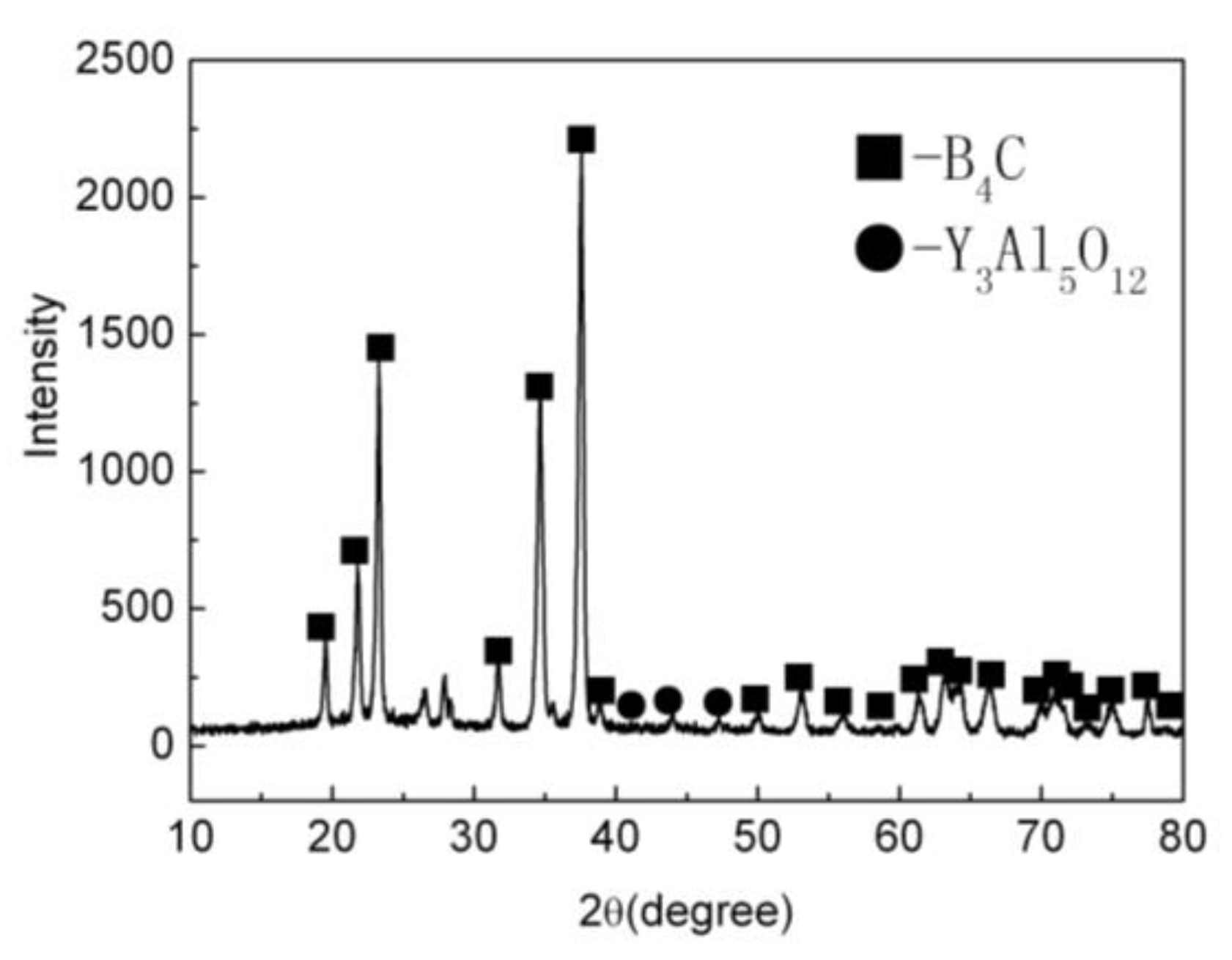
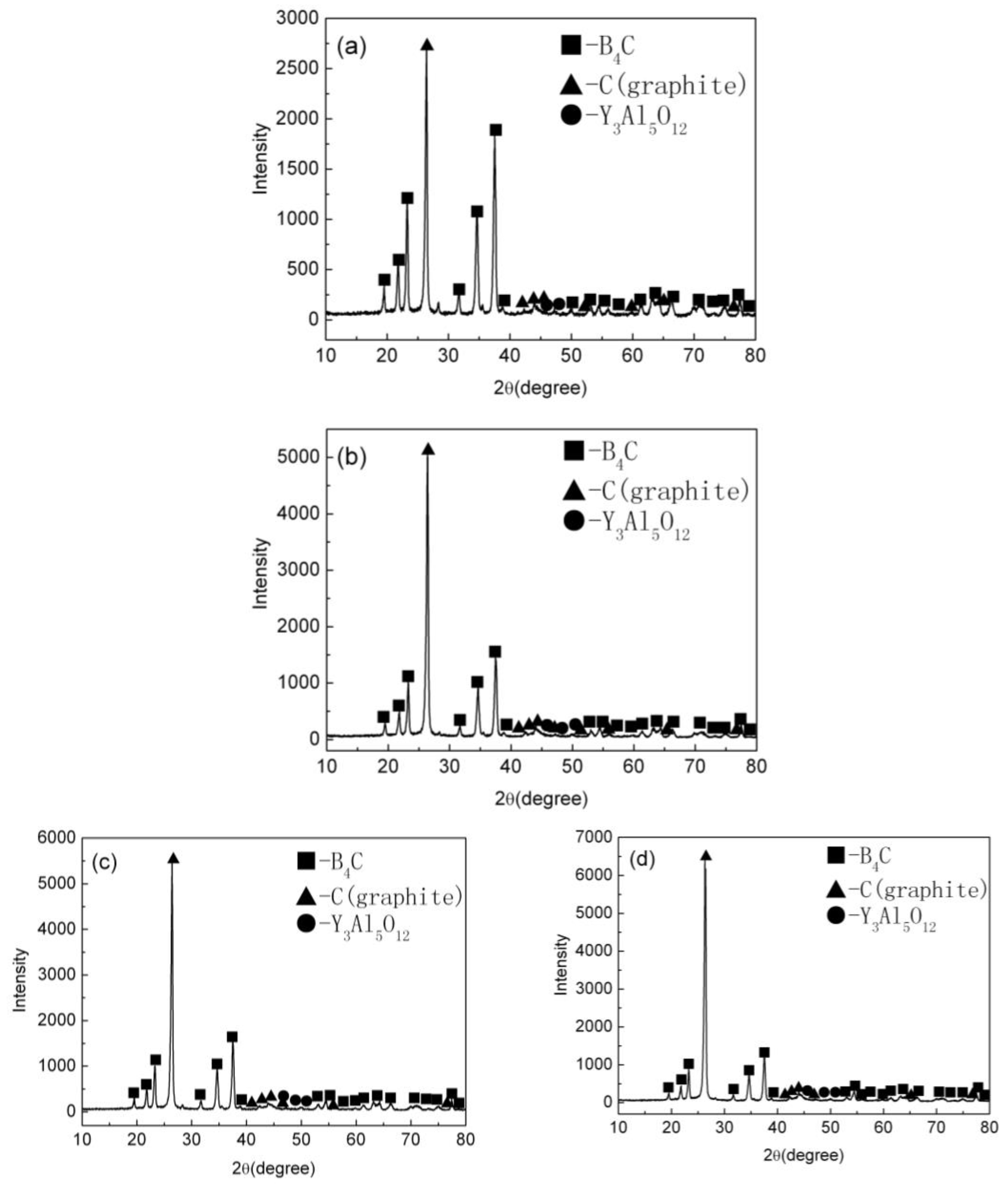
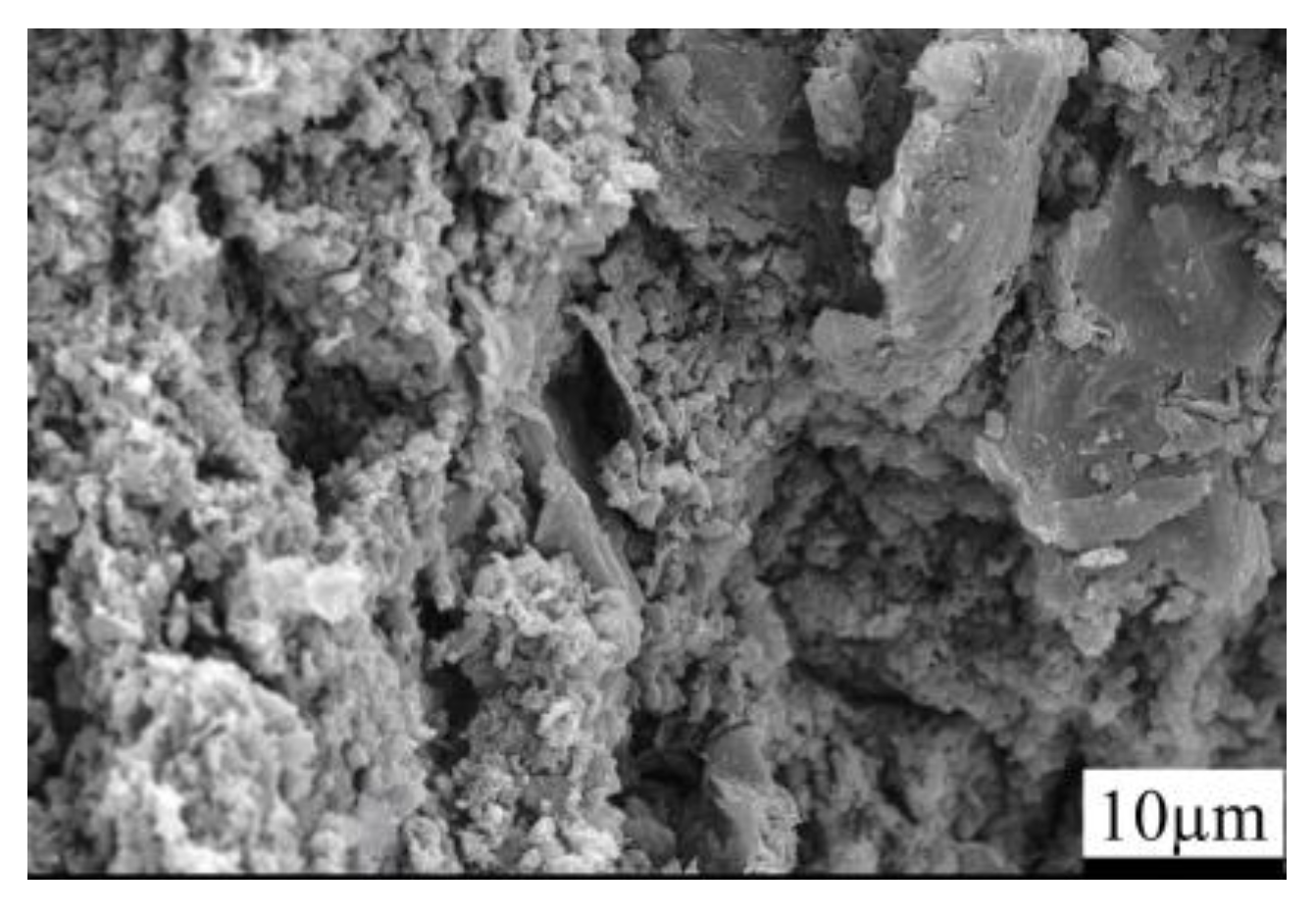


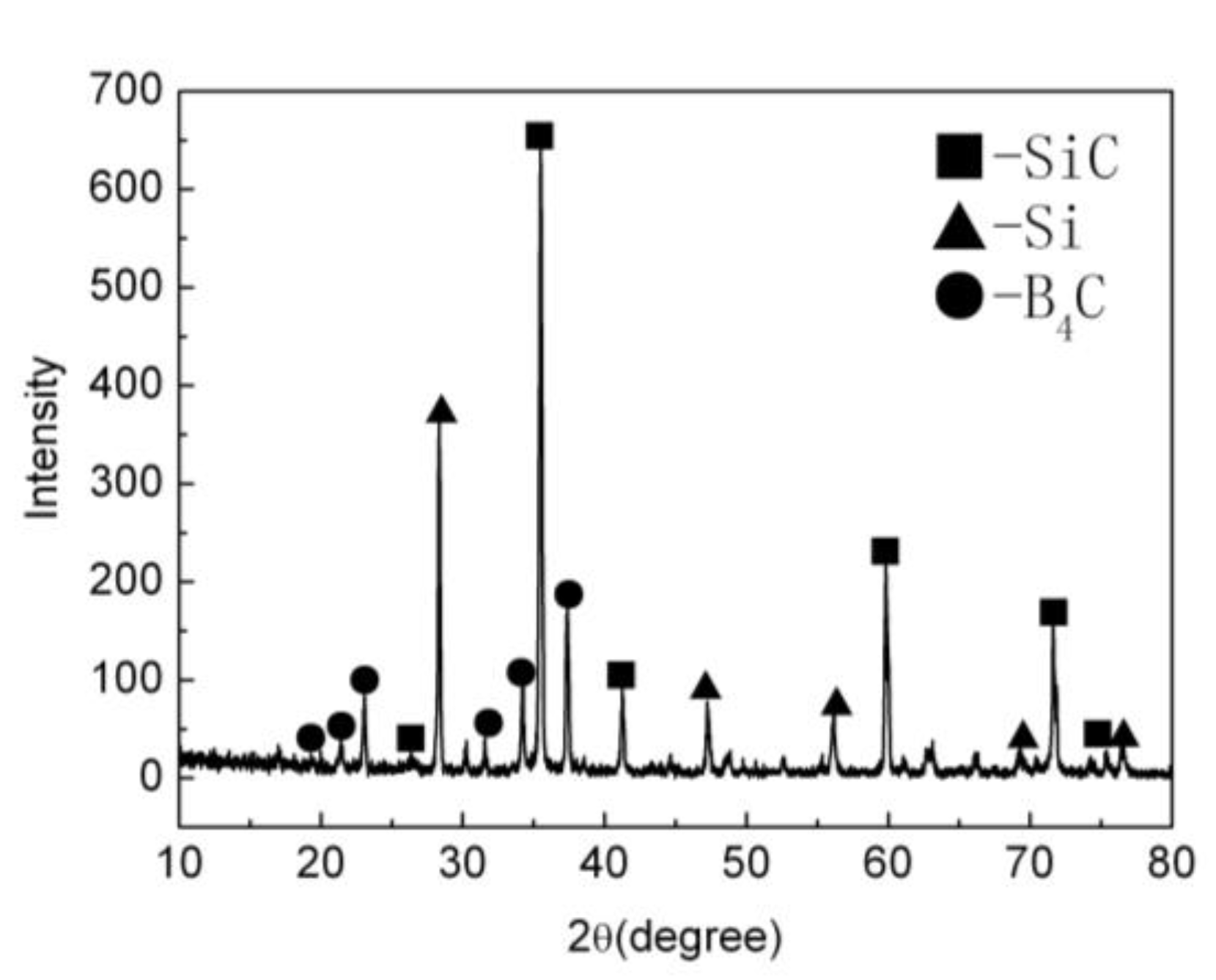
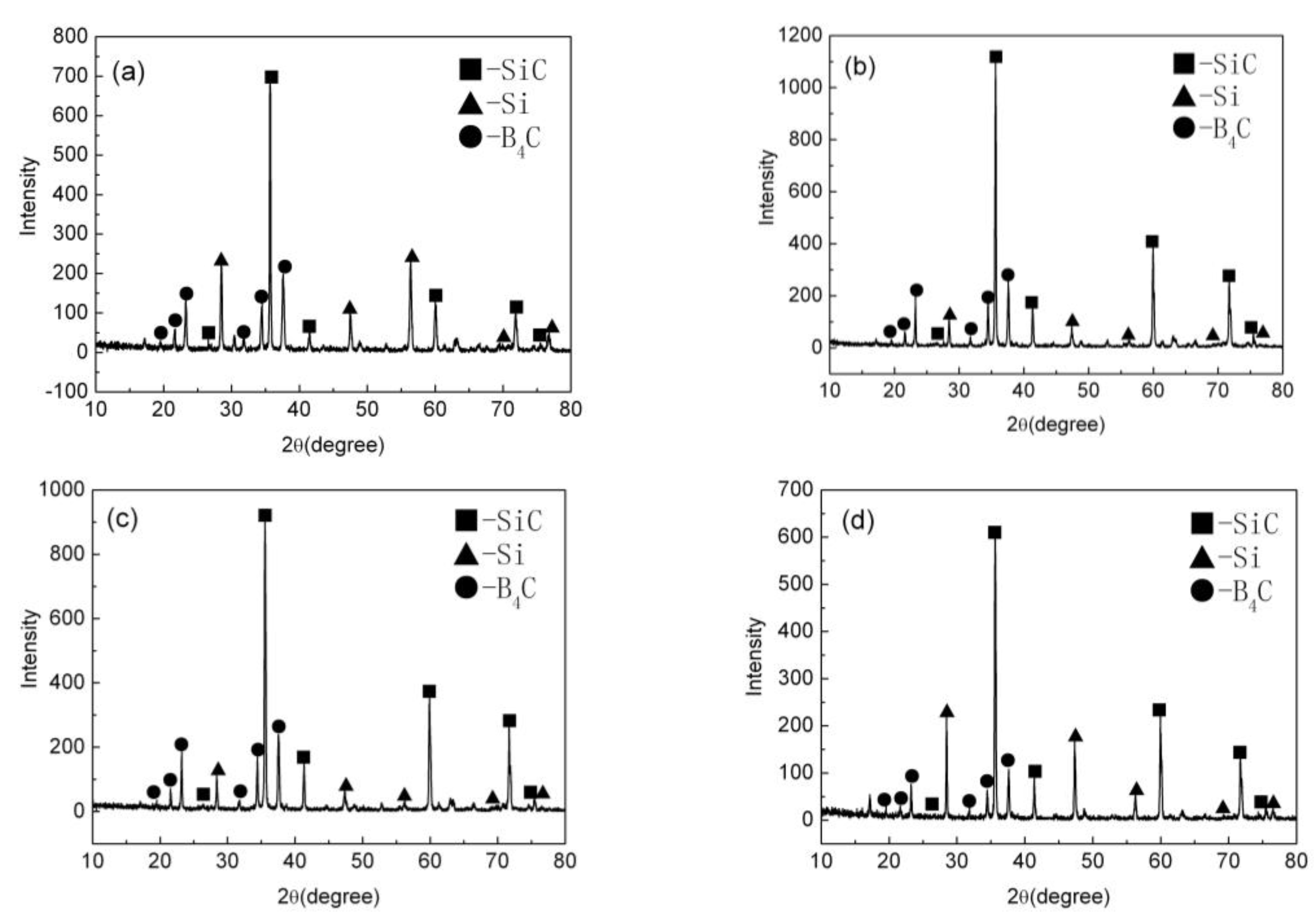
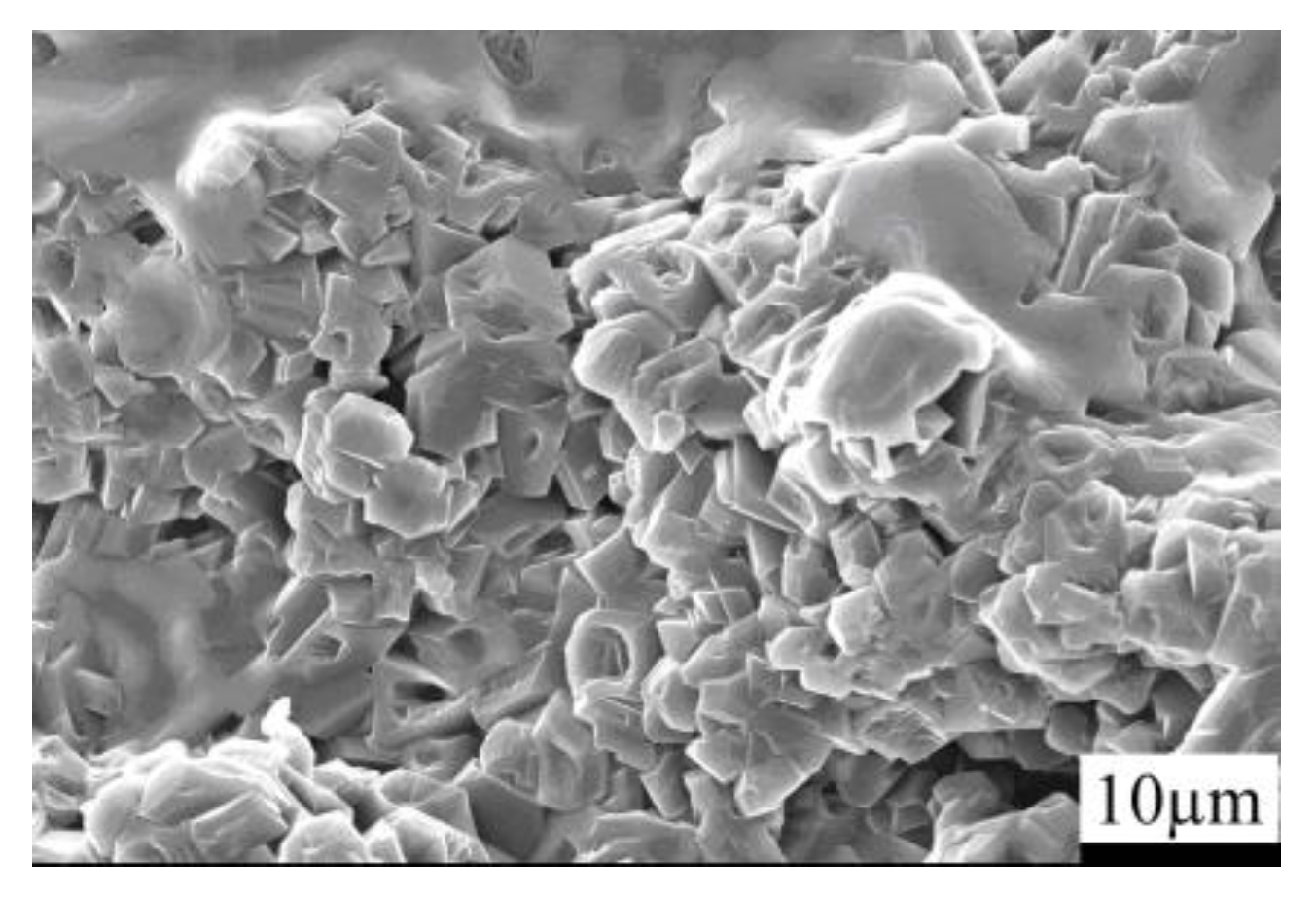

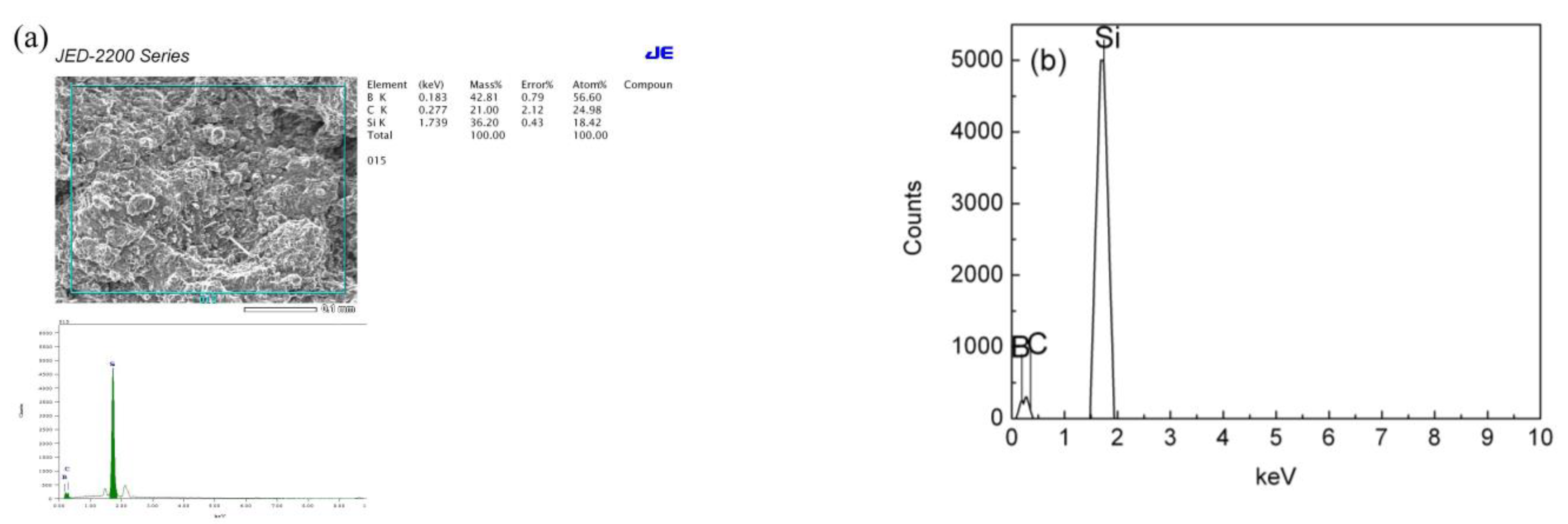
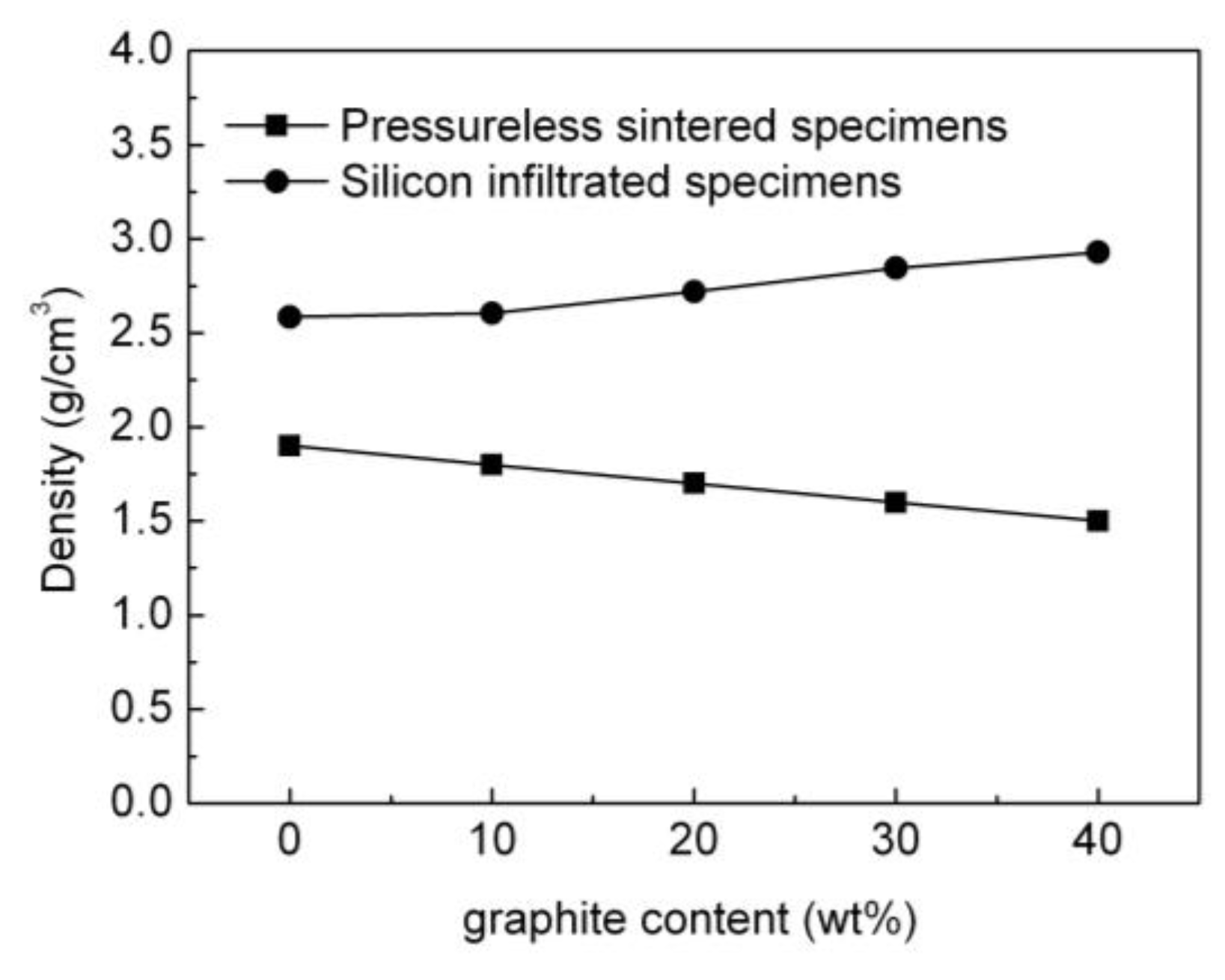
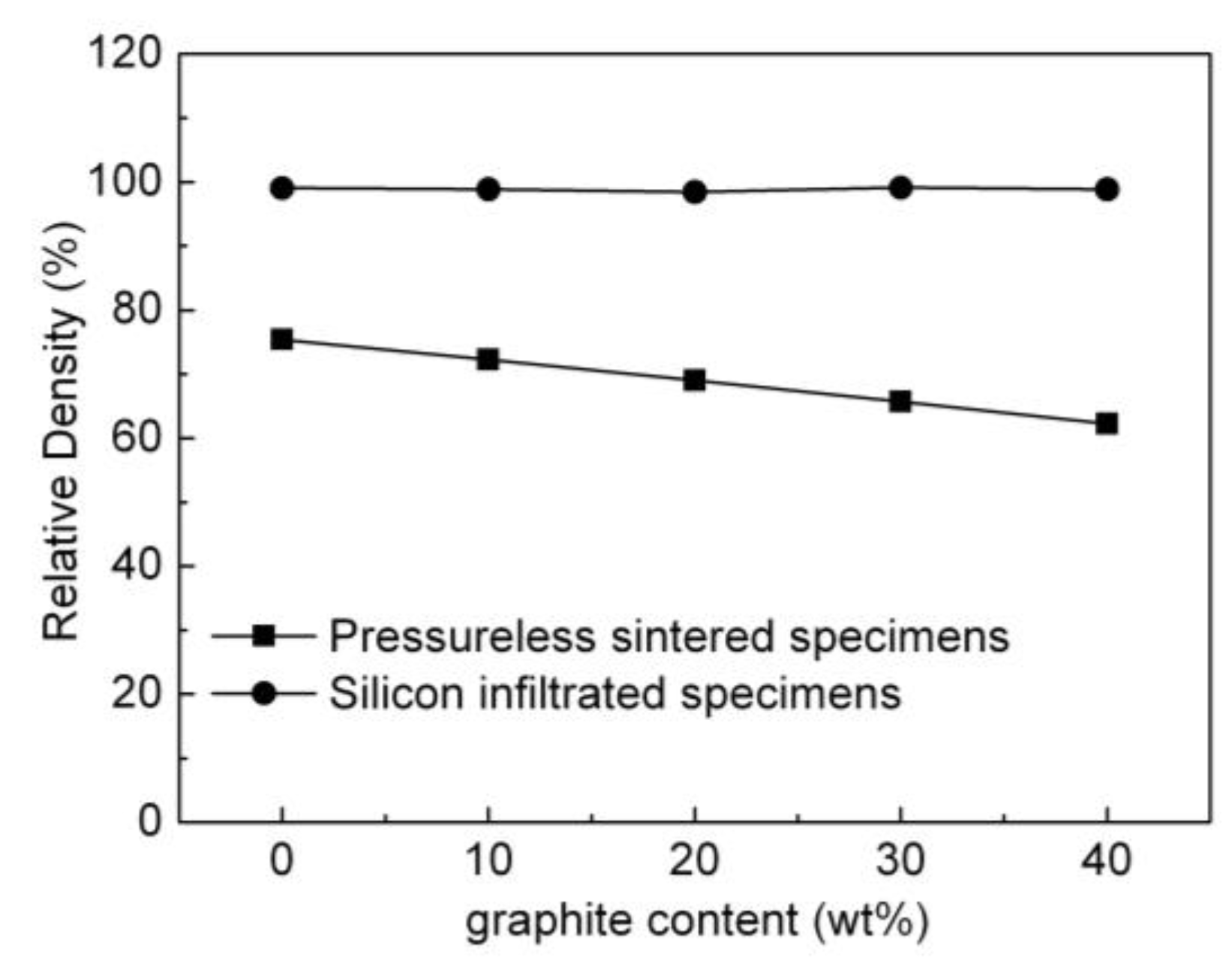
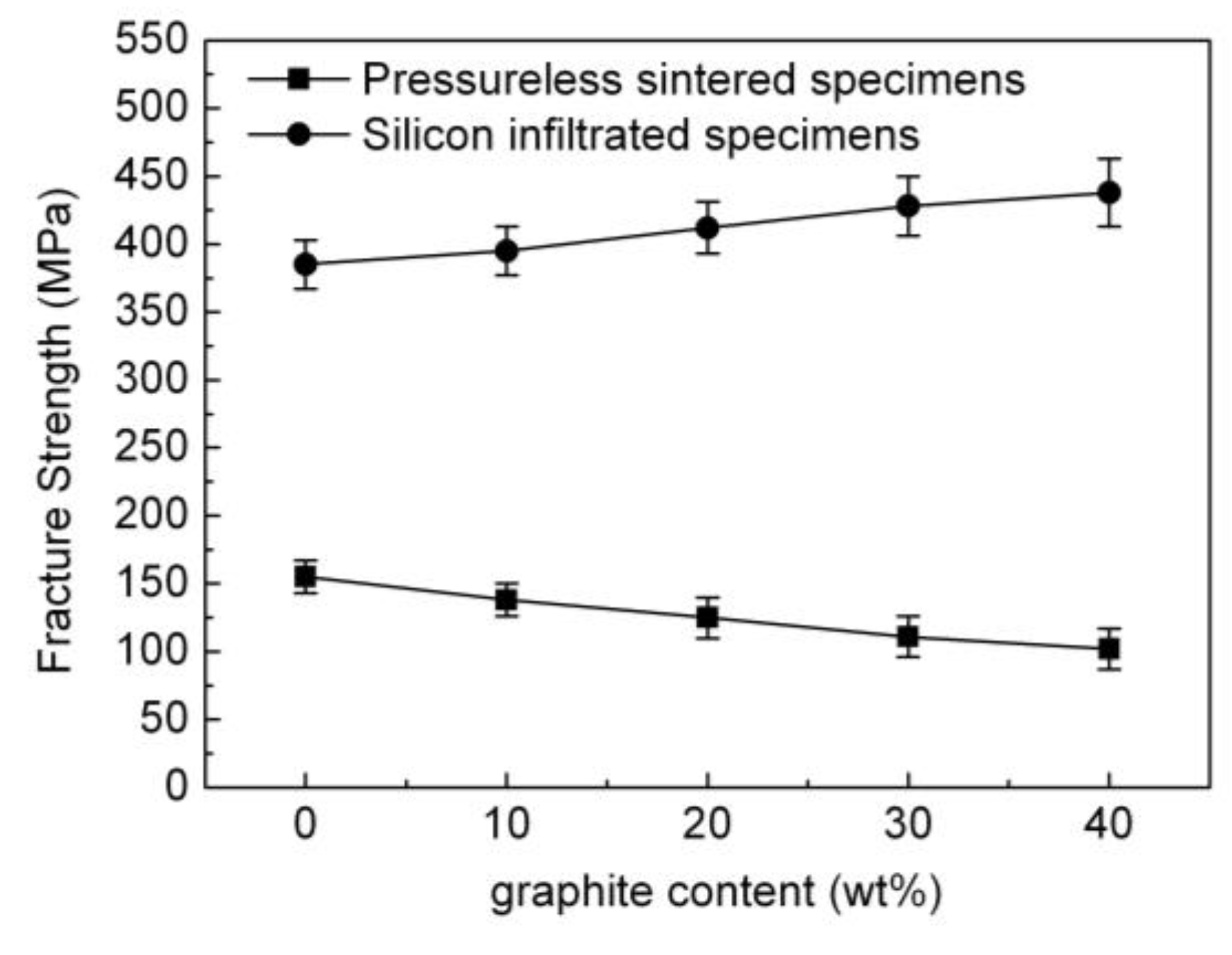

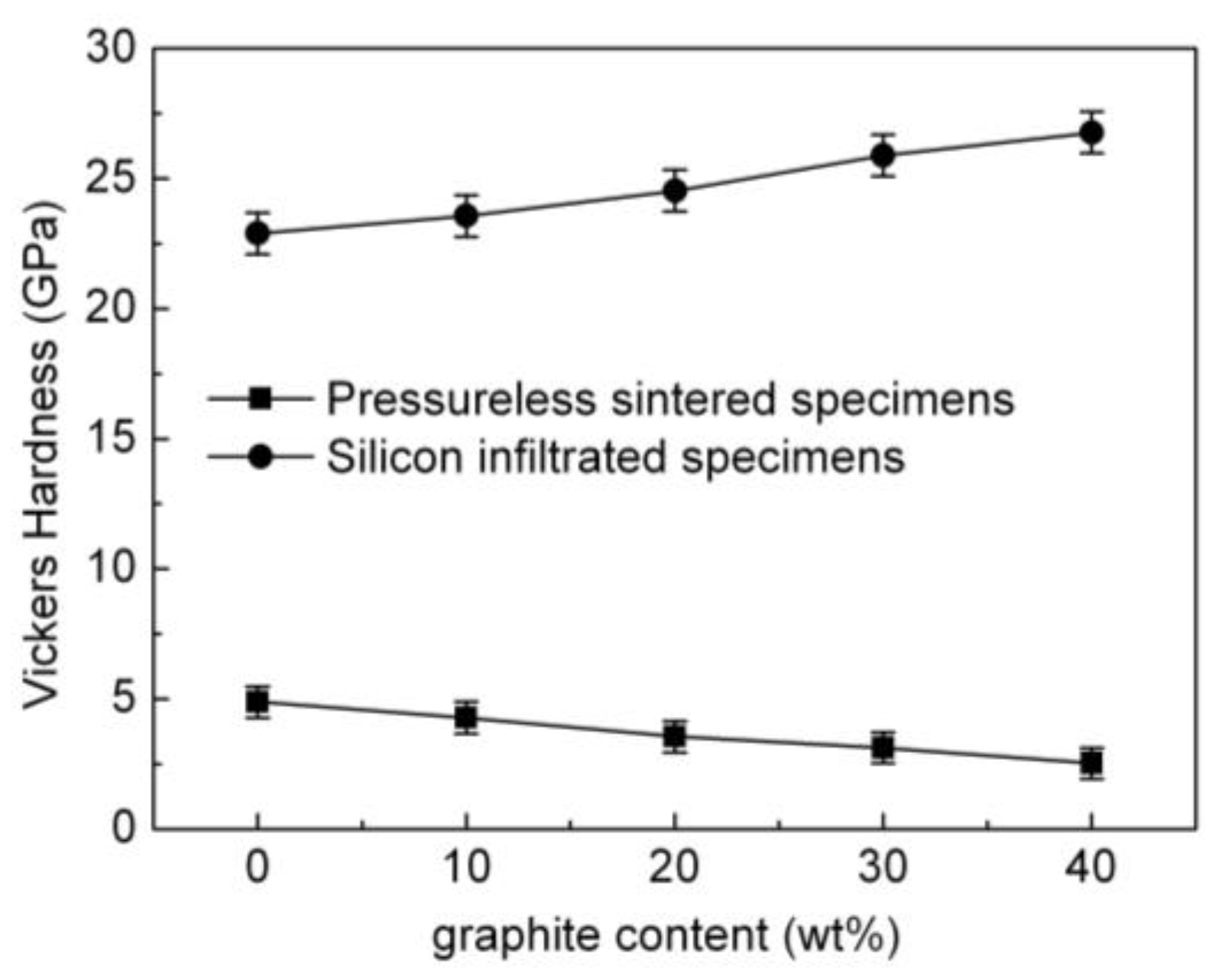
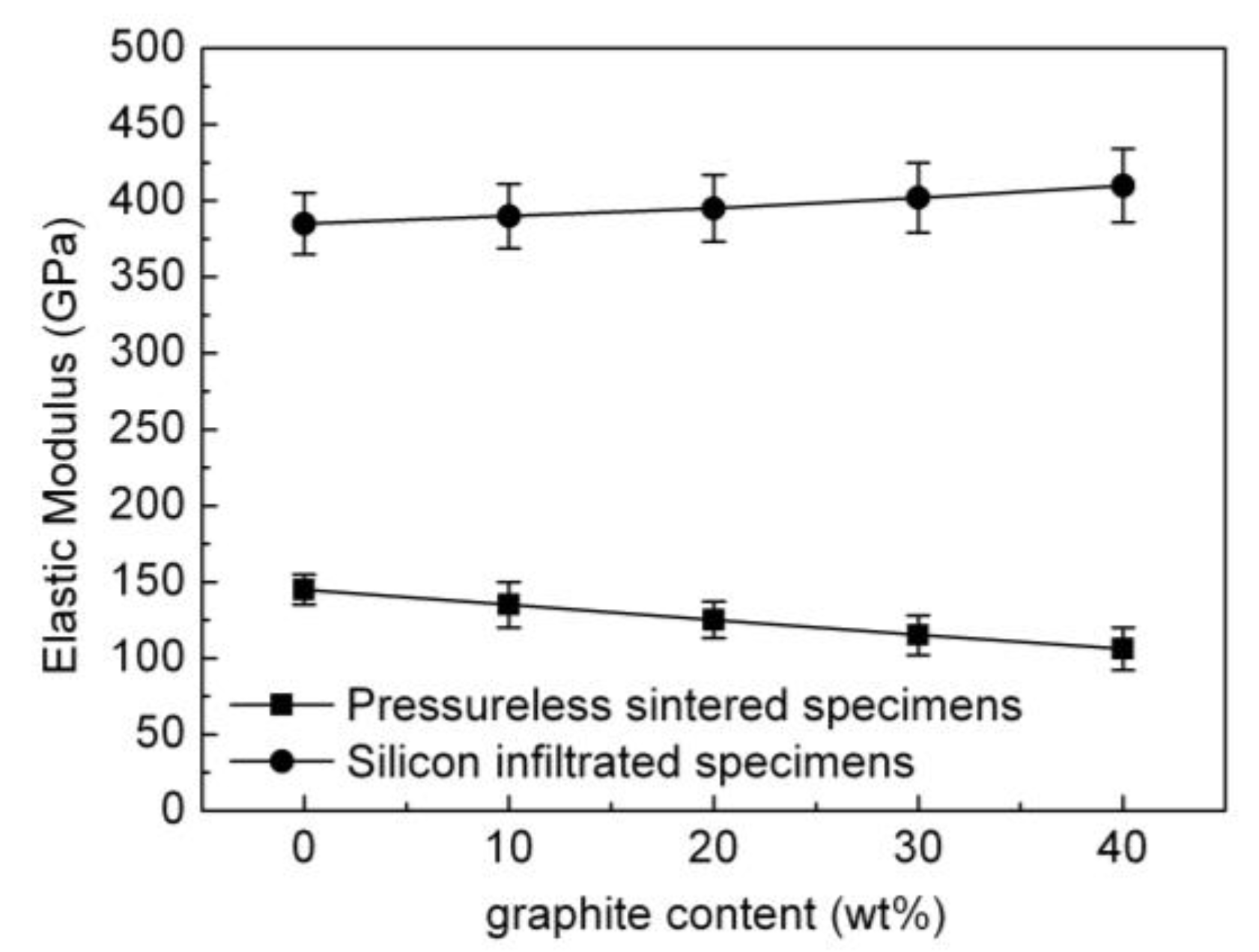
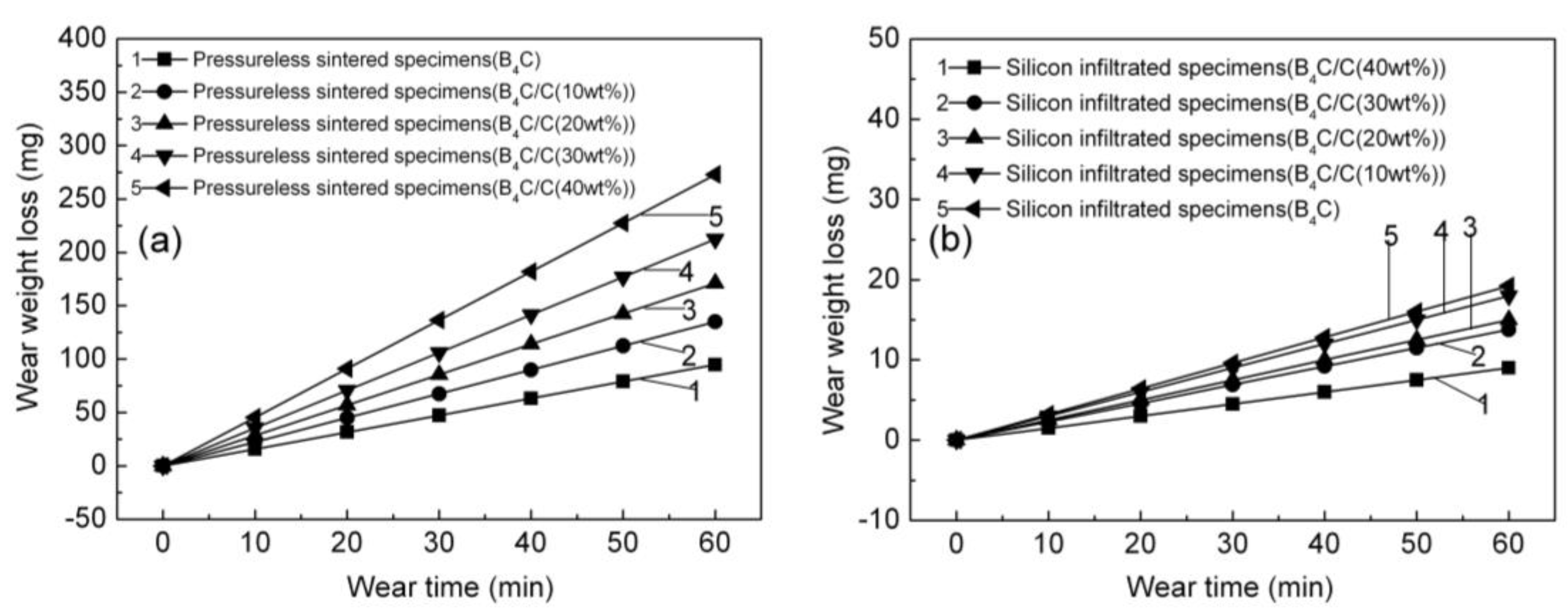
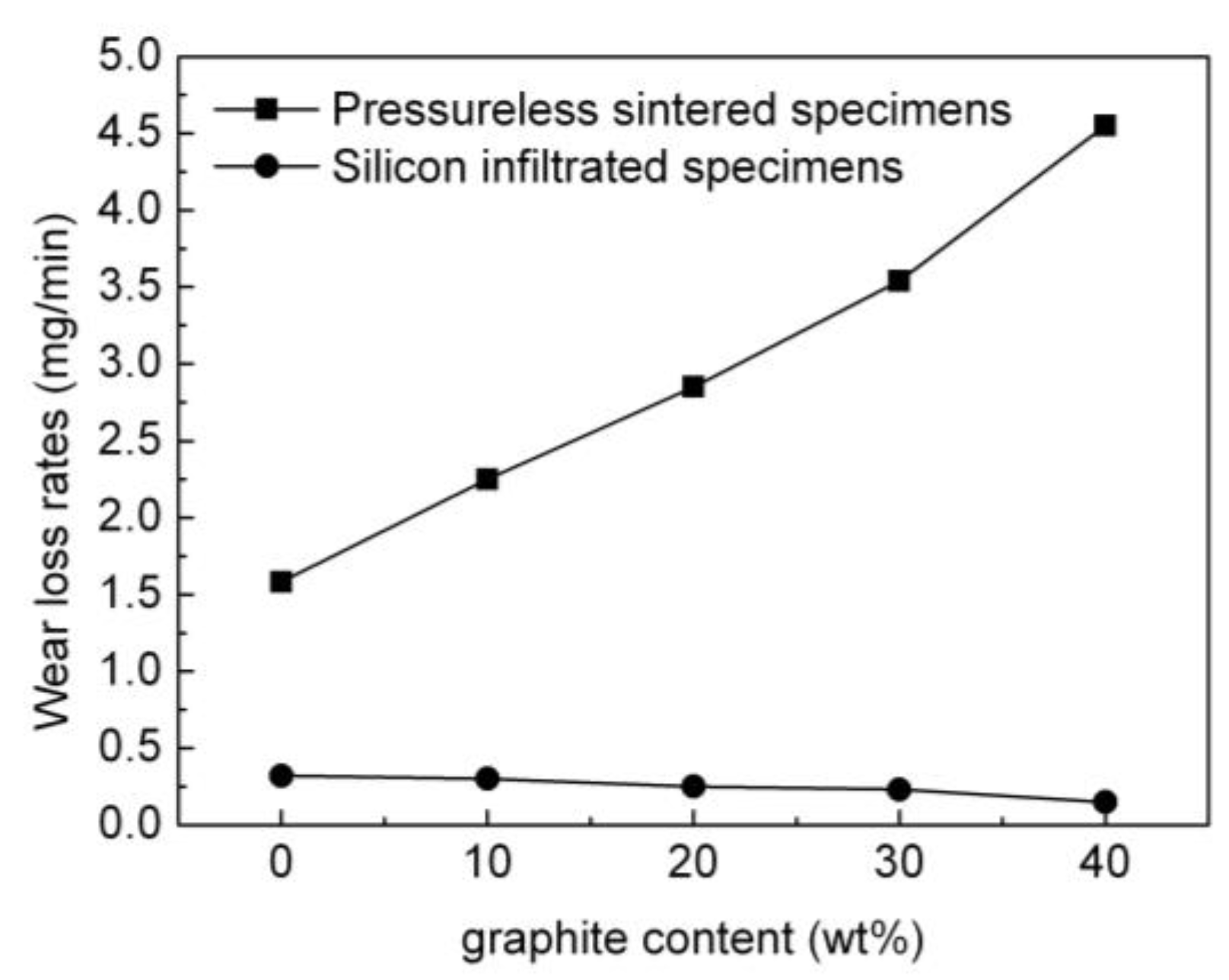
Publisher’s Note: MDPI stays neutral with regard to jurisdictional claims in published maps and institutional affiliations. |
© 2022 by the author. Licensee MDPI, Basel, Switzerland. This article is an open access article distributed under the terms and conditions of the Creative Commons Attribution (CC BY) license (https://creativecommons.org/licenses/by/4.0/).
Share and Cite
Jiang, T. Investigation of Microstructural Features and Mechanical Characteristics of the Pressureless Sintered B4C/C(Graphite) Composites and the B4C-SiC-Si Composites Fabricated by the Silicon Infiltration Process. Materials 2022, 15, 4853. https://doi.org/10.3390/ma15144853
Jiang T. Investigation of Microstructural Features and Mechanical Characteristics of the Pressureless Sintered B4C/C(Graphite) Composites and the B4C-SiC-Si Composites Fabricated by the Silicon Infiltration Process. Materials. 2022; 15(14):4853. https://doi.org/10.3390/ma15144853
Chicago/Turabian StyleJiang, Tao. 2022. "Investigation of Microstructural Features and Mechanical Characteristics of the Pressureless Sintered B4C/C(Graphite) Composites and the B4C-SiC-Si Composites Fabricated by the Silicon Infiltration Process" Materials 15, no. 14: 4853. https://doi.org/10.3390/ma15144853
APA StyleJiang, T. (2022). Investigation of Microstructural Features and Mechanical Characteristics of the Pressureless Sintered B4C/C(Graphite) Composites and the B4C-SiC-Si Composites Fabricated by the Silicon Infiltration Process. Materials, 15(14), 4853. https://doi.org/10.3390/ma15144853




